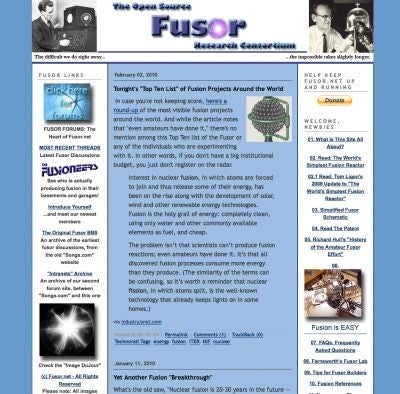Your support helps us to tell the story
From reproductive rights to climate change to Big Tech, The Independent is on the ground when the story is developing. Whether it's investigating the financials of Elon Musk's pro-Trump PAC or producing our latest documentary, 'The A Word', which shines a light on the American women fighting for reproductive rights, we know how important it is to parse out the facts from the messaging.
At such a critical moment in US history, we need reporters on the ground. Your donation allows us to keep sending journalists to speak to both sides of the story.
The Independent is trusted by Americans across the entire political spectrum. And unlike many other quality news outlets, we choose not to lock Americans out of our reporting and analysis with paywalls. We believe quality journalism should be available to everyone, paid for by those who can afford it.
Your support makes all the difference.In an attempt to solve the world's energy crisis, amateur scientists across America are developing homemade nuclear reactors with the help of online guide and science community fusor.net.
A trend for homemade nuclear reactors is developing amongst the amateur scientists of America. The BBC revealed on Wednesday that in an attempt to solve the world's energy crisis, a variety of enthusiasts have banded together on internet site www.fusor.net to discuss, learn about and build nuclear fusion reactors.
Nuclear fusion is the process a where atoms are forced to join together, causing a reaction which releases some of their energy, as opposed to fission, the current method of producing nuclear power where atoms are split. Nuclear fusion energy is considered by scientists to be the ultimate source of energy, clean, effective and only using widely available elements as a source of fuel. However, scientists have yet to produce a fusion reactor capable of producing more energy than it consumes.
The group of physics enthusiasts centered on www.fusor.net are attempting to build their own reactors, and try their hand at solving this energy conundrum. The website contains a message board which includes 23 pages of introductions from enthusiasts all over the United States as well as postings from science admirers as far away as Japan and Germany. There is also a general discussion forum in which enthusiasts debate the pros and cons of various components and inform others about the results of their experiments. The website contains downloadable tips on how to build your fusion reactor, a nuclear fusion news feed and even a FAQ section.
These amateur scientists are competing to solve the fusion problem with giant experimental nuclear projects such as the 840 meter, 23,000 ton Tokamak reactor, part of the Euro International Thermo Nuclear Reactor (ITER). The project which is expected to be completed by 2018, will cost 10 billion euros and is funded by seven regions - the European Union, South Korea, USA, Russia, China, India and Japan.
Fission nuclear power plants provided 14 percent of the world's energy in 2009, France and Slovakia generate the largest percentage of their electricity through nuclear power at 75.2 percent and 53.5 percent respectively.

Join our commenting forum
Join thought-provoking conversations, follow other Independent readers and see their replies
Comments